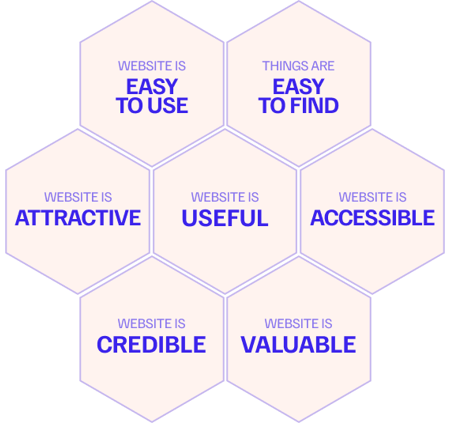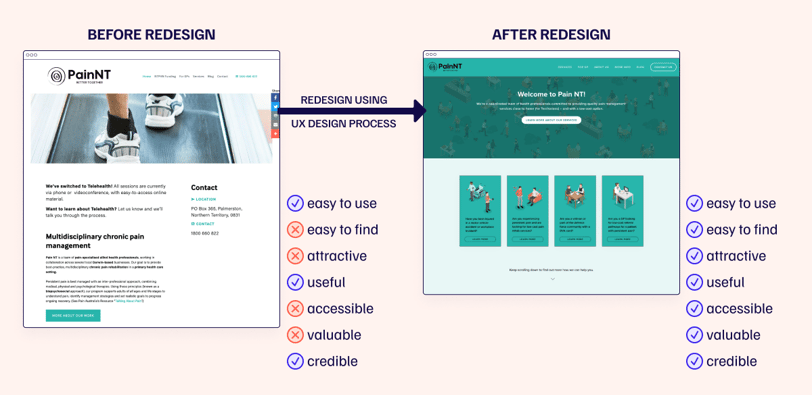What is UX Design – and why do you need it for your business website?
Want your website to attract more high-quality customers? Make sure it's easy to use and enjoyable for visitors. That’s where UX design comes in.
WEBSITEUX/GRAPHIC DESIGNSTRATEGY
10/7/2024


I'll be honest with you — UX design is easy to understand, but not easy to execute.
Still, through my experience of working with more than 10 small businesses & startups on their websites, UX design has been a key factor in their success, beating previous KPIs — and outperforming competitors.
What is UX Design?
UX design = User Experience design.
UX design is the art of crafting a positive experience for people when using a product or service, in this case, your website.
If you want your website to be effective, it needs to be more than just hold information. It needs to be useful, easy to use, attractive, easy to find, accessible to everyone, believable, and valuable.
Let's break that down:
Useful: Your website should help people find what they need. Don't just follow the rules – think outside the box and create something that's truly helpful.
Easy to use: Make sure your website is easy to navigate. People shouldn't get lost or confused.
Attractive: Your website should look good. Use pictures, colors, and fonts that make it appealing.
Easy to find: People should be able to find your website easily when they search online.
Accessible: Everyone should be able to use your website, including people with disabilities. This is the right thing to do, and it's also becoming a legal requirement.
Credible: People need to trust what your website says. Make sure your website looks reliable and trustworthy.
Valuable: Your website should help your business achieve its goals. If you're a non-profit, it should help you achieve your mission. If you're a for-profit, it should help you make money and keep your customers happy.
7 factors of UX design, based on the User Experience Honeycomb as developed by Peter Morville.
Basically, UX design is about making your website user-friendly, easy and enjoyable to use. If you were to put yourself in your website visitor's (aka customer's) shoes, you'd be thinking like this:


In short, the main reason why you need UX Design is:
The better your website UX design is, the more likely customers enjoy doing business with you, and the better it is for your business (in the short and the long-term).
Now that we've addressed why UX is needed now more than ever for your business, let's talk about the specific reasons how UX design helps you with your website:
5 specific reasons why you need UX design for your website
1.Saves you the confusion about what to put on your website
What exactly do you need on your website?
Actually, the answers don’t even need to come from you – for the most part.
When you understand what your visitors need from you with your website, it’s no longer a puzzle to figure out what you need to include there.
UX design is like a map you use to achieve a high-quality website. Your main focus is putting – and designing – content on your website that is useful for your visitors to act on. You’re also integrating your branding and business objectives every step of the way, so you never lose sight of your revenue and profitability.
2.Saves you the time and cost of building and maintaining your website
Often, the most consuming time is the initial stage of website development or redesigning.
UX design relies on processes and principles that are aimed at serving your visitors/clients. It’s systemised. It also gives you more clarity on what works and what doesn’t with your website.
This means fewer mistakes – less waste of time and money.
Here's an example from my previous project:
When the Pain NT (as the example above) website needed a redesign, the owners just wanted to get as much information online as possible. They didn’t have a clear strategy or plan.
Instead of redesigning the website without a plan, we used a customer-focused UX design process. We broke down the project into stages, focusing on things like:
What the website needed to achieve
How customers would move through the website
The layout and design
Clear and effective writing
This helped us finish the project faster — reduced from 10 weeks to 6 — and avoid wasting money on things that didn't really matter.
3.Easier to deliver a seamless experience for your visitors
Think back to the time when you experienced a great time with any service. Be it at a restaurant, a hotel, an app or a website. Was the experience easy or confusing? Was it enjoyable or frustrating?
UX design is the process you use to design these experiences for your website. In fact, it allows you to even consider the experience before and after they visit your website, giving you more opportunities to delight your website visitors. The more you delight, the better impression you have with your visitors.
You don’t have to rely on guesswork about how to deliver that enjoyable experience anymore.
4.Easier to build trust and credibility with cold and warm traffic
We often perceive aesthetically pleasing design as design that’s more usable and trustworthy. It’s a phenomenon described as Aesthetic-Usability Effect.
UX design gives you more control over how you can create your website content to make it easier for visitors to trust you. This is because:
They're not distracted by poor navigation. Great design delivers a seamless experience when they’re on your website.
They have a reason to trust you because you’re giving them the exact content they want and need from you (based on your design research).
If you’re in the healthcare industry, the key elements of your website contents are deliberately designed to keep within the AHPRA Regulations. There’s no need for “sleazy” or “risky” marketing tactics that might risk your business being penalised.
Even if they’re not planning to be your customer or client, at the very least, you appear credible for them refer to their peers, friends or family.
5.Increases conversion – without using “unethical” marketing techniques
In fact, you don’t need to use “smart” marketing persuasion tactics that make you feel uneasy and unethical.
UX design process focuses on mindful and intentional design principles to convey your honest brand, your reliable team, and yourself as a professional. It allows you to build genuine engagement and connection so you don't need to be a sleazy salesman to get that sale – but instead, build enough (if not a lot of) trust with your customers to them to do business with you.
Conclusion
So, if you're considering to create or update your website, I highly recommend you to use UX design as part of your core strategy. Not only it'd help your business monetarily, but also:
Avoid confusion: Figure out exactly what your website needs.
Save time and money: Build and maintain your site more efficiently.
Create a great experience: Keep visitors happy and coming back.
Build trust: Establish credibility and reliability.
Increase conversions: Get more people to take action without shady tactics.
Goodluck!
— Farah :)
Example of a website I redesigned using UX design processes
“How easy is it to be using your website to get what I want from it?”
As a customer, you want a website that's easy to use and find what you need. A bad website can leave a bad taste in your mouth, even if you're just browsing.
Case Study: PainNT website redesign
In 2021, I redesigned the PainNT website. While their old site was informative and trustworthy, it wasn't always clear what they did, what they offered, or what to do next.
Using UX design, we focused on making the website more informative, user-friendly, visually appealing, and strategically sound. We also kept costs low to fit their business model.
The results were impressive: Website traffic increased by 100%, and time-consuming customer support inquiries dropped by 70%. The UX design strategy not only helped customers find the information they needed but also made it easier for the PainNT team to do their day-to-day work.
Get in touch
hello@mindfulgrowthtips.com
© 2024 Mindful Growth Tips
